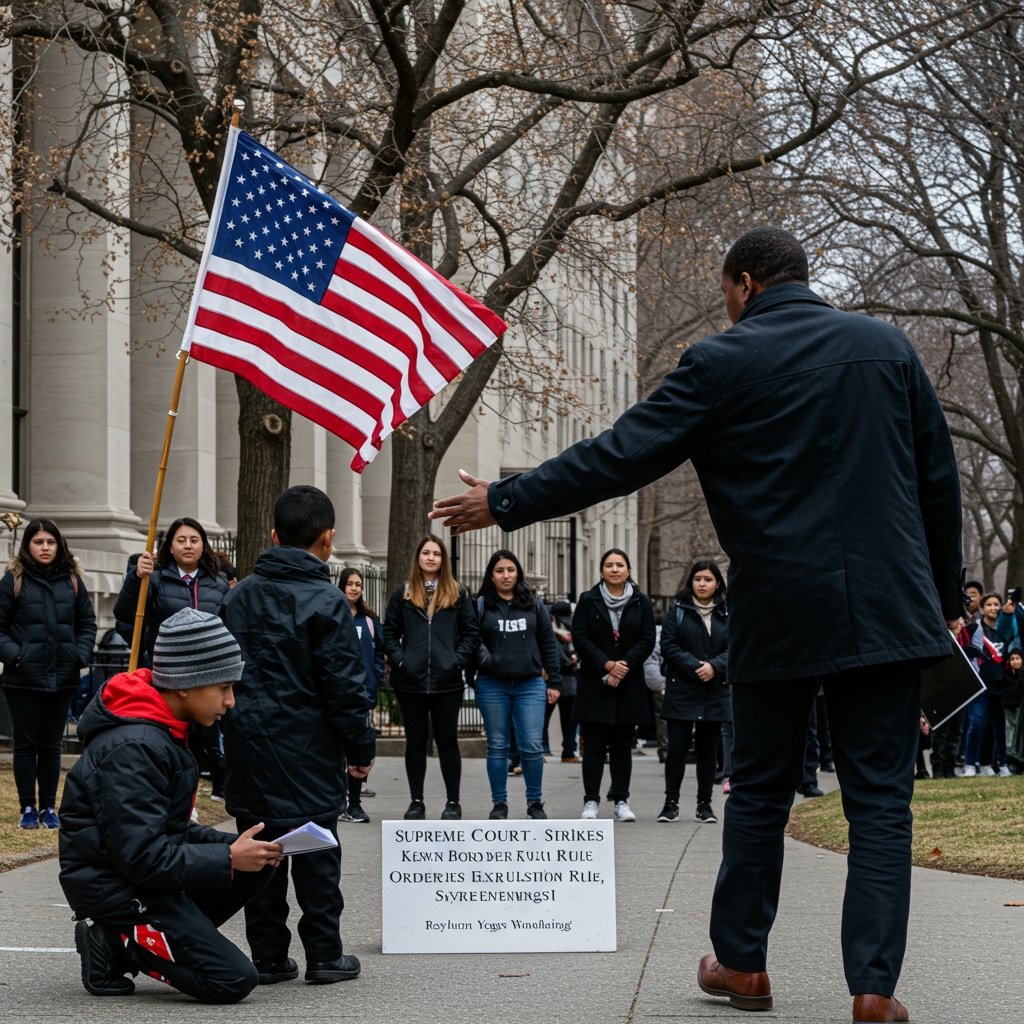Supreme Court Invalidates Core Border Expulsion Policy
WASHINGTON, D.C. – The U.S. Supreme Court today delivered a significant ruling in the case Gonzalez v. DHS, striking down a central provision of the Department of Homeland Security’s controversial “Immigration Management Directive 2025-A.” The decision, issued on March 10, 2025, found that the directive’s mandate requiring the immediate expulsion of asylum seekers specifically from certain nations violated both established federal law and the fundamental due process requirements enshrined in the U.S. legal system.
The ruling marks a pivotal moment for U.S. border policy and the legal rights of individuals seeking protection at the southern border. It effectively dismantles a key tool the administration had employed to manage high levels of migration by expediting removals, particularly impacting operations along the U.S.-Mexico border.
Background on Immigration Management Directive 2025-A
Introduced earlier to address unprecedented challenges in processing asylum claims and managing border flows, the “Immigration Management Directive 2025-A” aimed to streamline procedures and enhance border security. A core element of the directive was the provision enabling Customs and Border Protection (CBP) and other designated border agencies to quickly remove migrants without providing a full hearing on their asylum claims. This was particularly applied to individuals from specific countries, based on various factors cited by the Department of Homeland Security (DHS), including diplomatic relations, migration patterns, and perceived security risks associated with rapid processing.
The rationale behind this expedited expulsion mechanism was to reduce pressure on immigration courts and detention facilities, theoretically allowing resources to be focused on other enforcement priorities. However, critics argued from its inception that the directive bypassed critical legal safeguards designed to protect individuals fleeing persecution and seeking asylum under U.S. law and international conventions.
The Legal Challenge: Gonzalez v. DHS
The challenge to the directive culminated in the Supreme Court case Gonzalez v. DHS. The plaintiffs, represented by a coalition of legal aid organizations and civil rights groups, argued that the directive’s expulsion provision was ultra vires (beyond legal authority) because it conflicted with existing federal statutes governing asylum procedures. Specifically, they contended that U.S. law mandates a process for individuals expressing a fear of persecution upon arrival, known as the credible fear screening. This process allows asylum officers to determine if an individual has a significant possibility of establishing eligibility for asylum or protection from removal.
Furthermore, the plaintiffs argued that denying individuals the opportunity for such a screening before removal constituted a violation of their due process rights under the Fifth Amendment of the U.S. Constitution. They maintained that even non-citizens are entitled to a basic level of due process when facing removal from the United States, and the directive’s immediate expulsion provision failed to meet this standard, particularly for those potentially facing danger in their home countries.
The Supreme Court’s Decision
In its majority opinion, the Supreme Court agreed with the plaintiffs, finding that the “Immigration Management Directive 2025-A” provision for immediate expulsion of asylum seekers from specific nations was inconsistent with federal law. The Court’s reasoning hinged on interpreting congressional intent as expressed in the Immigration and Nationality Act (INA), which outlines the framework for asylum processing. The justices concluded that Congress had established a specific legal pathway for asylum seekers, including the initial credible fear screening, and that the DHS directive unlawfully circumvented this congressionally mandated process.
The Court also addressed the due process arguments, ruling that the directive’s failure to provide any meaningful opportunity for asylum seekers to articulate their fear of return before expulsion did indeed violate their due process rights. The opinion emphasized that while the government has broad authority over immigration matters, this authority is not unbounded and must operate within the constraints of federal statutes and constitutional protections.
Impact on Border Operations
The immediate practical consequence of the ruling is that CBP and other relevant border agencies must cease the practice of immediately expelling asylum seekers from the nations previously targeted under the directive. Instead, these agencies are now legally required to revert to the standard protocol: providing individuals who express a fear of returning to their home country the opportunity to undergo an individual credible fear screening by a trained asylum officer.
This shift will undoubtedly impact processing operations along the U.S.-Mexico border. Experts anticipate that it will likely lead to longer processing times for asylum seekers, potentially increasing the number of individuals held in temporary custody or released into the U.S. with notices to appear in immigration court. The directive had been credited by the administration with helping to manage border numbers, and its invalidation necessitates a recalculation of resource allocation and operational strategies by DHS.
Reactions and Future Implications
The ruling was met with strong reactions from various stakeholders. Advocacy groups, including the ACLU (American Civil Liberties Union), were quick to praise the decision. In a statement, the ACLU hailed the ruling as a crucial defense of asylum rights and a reaffirmation that the U.S. must adhere to its legal obligations to individuals seeking safety. They argued that the directive had endangered vulnerable people by sending them back to potentially perilous situations without a fair hearing.
Conversely, some border security advocates and government officials expressed concern about the operational challenges the ruling presents. They argued that the directive was a necessary measure to handle overwhelming numbers of migrants and that the return to lengthier processing will strain resources and could potentially encourage more irregular migration.
Looking ahead, the decision may prompt Congress to consider legislative action to address the issues surrounding asylum processing and border management. It also underscores the ongoing tension between executive branch efforts to control borders and the statutory and constitutional rights afforded to individuals seeking protection under U.S. law.






